The Norwegian archipelago of Svalbard is one of our favourite destinations, with jaw-dropping landscapes and impressive wildlife. However, Svalbard isn’t just about the majestic scenery – it’s also home to an incredible array of Arctic birds, if you know what you’re looking for.
Here are some of unique feathered friends that nest in this region that birdwatchers should keep their eyes peeled for.
Northern Fulmar
(Fulmarus Glacialis)
Found throughout the North Atlantic, the northern fulmar is characterised by its stocky build and grey-brown head and underside, with light markings on top of its wings. Its chunky bill has small tube-like nostrils, like other members of the procellariiformes family.
You may spot fulmar at their preferred breeding grounds on the coastal cliffs of Svalbard, or out at sea on one of its long hunting trips.
Barnacle Goose
(Branta Leucopsis)
These medium-sized geese make their home on the Svalbard peninsula, particularly around the island of Spitsbergen. The male and female geese are indistinguishable from each other, with their grey-black wings, black necks and white markings around their eyes.
Measuring up to 70 cm long and weighing in at around 1.5-2 kgs, the barnacle goose often breeds in crowded colonies, migrating south towards Scotland during the winter.
Kittiwake
(Rissa Tridactyla)
One of the most common Arctic birds to spot, the black-legged kittiwake is a medium-sized gull that spends a lot of its time on the open sea. You can recognise them by their grey wings tipped with black feathers, as well as their yellow bills, white bodies and black feet.
Its call is fairly melodious, especially at its steep cliff nesting sites, where you’ll hear calls of ‘kitte-wake” from one bird to another – giving the bird its English name.
Arctic Skua
(Stercocarius Parasiticus)
One of the most populous species of skua, the Arctic skua is found in abundance on north Atlantic coastlines. You can recognise it by its grey brown wings and back, with a white chest and neck, topped with a darker cap of feathers.
Also called parasitic jaegers, the Arctic skua is a cunning scavenger that doesn’t hesitate to stealing food from terns and gulls to supplement its diet of rodents, insects and small birds.
Atlantic Puffin
(Fratercula Arctica)
This parrot of the sea is instantly recognisable by its bright, orange-red beak and feet. It has a stocky body with a white chest and jet black wings, and commonly lives in large groups in caves. However, due to the inhospitable conditions and permafrost in Svalbard, the puffins here usually nest on steep cliff faces.
Puffins tend to breed on the western coast of Spitsbergen and on Bjørnøya, with 50 colonies believed to exist across Svalbard. You can find out more about this colourful character in our Atlantic Puffin Wildlife Fact File.
Common Guillemot and Brünnich's Guillemot
(Uria Aalge and Uria Lomvia)
The common guillemot is the largest of the extant auk family, with male and female birds having brown-black feathers down their back and wings that wrap around their neck and cover their head like a cloak. By contrast, their chests are bright white, tapering off to a pointed design at the base of their neck.
The Brünnich’s guillemot is slightly smaller than the common variety, and has a less pointed beak. They can also be distinguished from the common guillemot thanks to the thin white stripe that runs along the top of its mandible.
Arctic tern
(Sterna paradisaea)
This small bird is the only tern which breeds in Spitsbergen, coming in at about 35 cm in length and weighing just 100-125 g. You can identify it by the black cap of feathers on its head and red beak, as well as its white body and light grey wings.
In winter, these birds make the long trip to Antarctica, spending the months on the pack ice before returning to Spitsbergen around the beginning of June.
Twitching to spot Arctic birds on your next bird watching holiday?
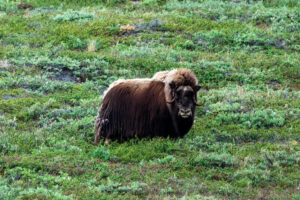
Arctic Complete – Svalbard, Greenland & Iceland
Gallery Zodiac-cruise through picturesque mountain landscapes A lone musk ox in Greenland in
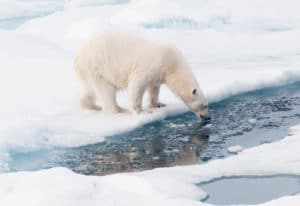
Svalbard Odyssey
Gallery Keep watch for polar bears on pack ice; A.Bakker Curious arctic foxes, Svalbard;

Jewels of the Arctic
Gallery Zodiac-cruise through the world’s largest fjord system Passengers spot musk oxen during
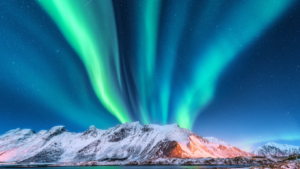
Northern Lights Explorer
Gallery Captured at Nordvestfjord & Eskimobugt on 13Aug, 2019 by Matt Horspool @Etchd Photography.
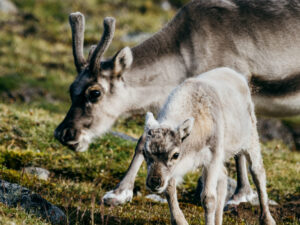
Iceland, Jan Mayen, Svalbard
Gallery Captured at Kongsbreen & Sarsfjellet on 05Aug, 2019 by Matt Horspool @Etchd Photography.
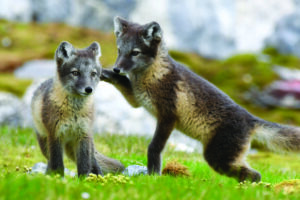
Svalbard in Depth
On this extended exploration of the Svalbard archipelago, there is ample time to enjoy the

Arctic & Beyond 2024 Season Brochure
Explore our Arctic & Global 2024 season, full of life changing adventures across the wildest and most remote destinations around the globe. Choose from 15 departures exploring the Arctic and 3 voyages to our hand-picked Global destinations.
Dive into our comprehensive 112-page brochure and find your next life-changing adventure.
